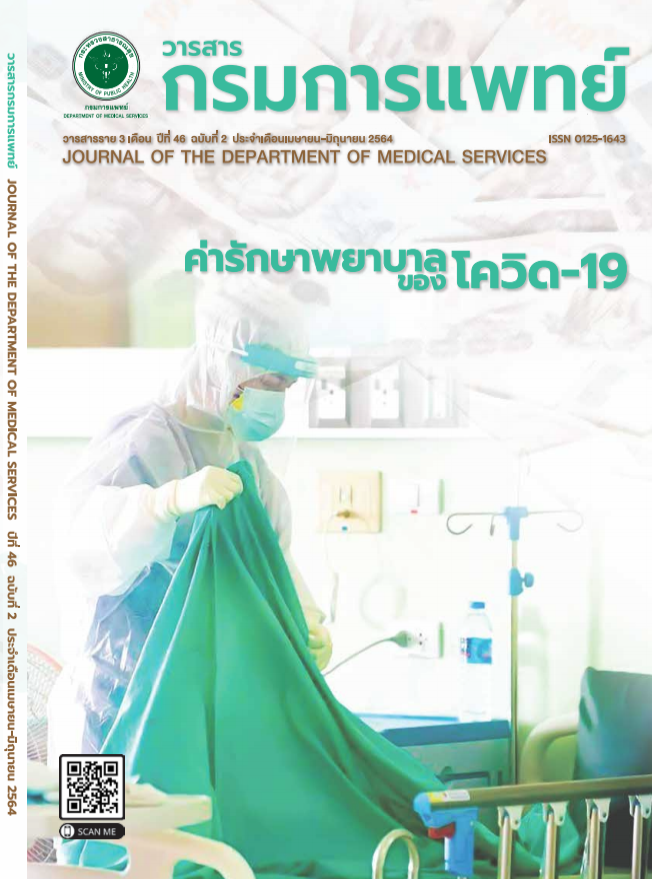The Effect of a Nursing Care Program Using Swanson’s Caring Model on Drug Administration Behavior of School-age Children with Epilepsy Parents
Keywords:
Nursing care, Swanson’s caring model, Drug administration behavior, School-age children with epilepsyAbstract
Background: Epilepsy is a common neurological disorder in children. Epilepsy is caused by an abnormal electrical discharge organ, causing convulsions in which the patient is unable to control their body movements.Objective: The purpose of this research was to study the effectiveness of applying Swanson’s caring model to medication administration nursing care program for parents of school - age children with epilepsy.Methods: The target population was 32 parents of epilepsy children aged between 6-12 years old who admitted at Queen Sirikit National Institute of Child Health. The population was divided into 2 groups: control group (n = 16) and experimental group (n = 16) with matching criteria of education. The control group received the normal nursing care, while the experimental group received drug administration nursing care program with an adaptation of Swanson’s caring model. The program lasted for 3 weeks. The research instruments were the nursing care program based on the concept of Swanson and the questionnaires on drug administration for parents of school-age children with epilepsy. The content validity was .83 and reliability analysis was .86. T-test was used to determine significant difference between the two groups.Results: (1) drug administration by parents in the experimental group improved after receiving the nursing care program using Swanson’s caring model (2) drug administration by parents in the experimental group also improved more than the control group.Conclusion: These findings revealed nursing activities which promoted drug administration by parents of school-age children with epilepsy. The effective nursing care include five components of Swanson’s caring model that lead to individual practice confidence, hope, encouragement and belief in practicing correct drug administration.
References
Camfield P, Camfield C. Incidence, prevalence and aetiologyof seizures and epilepsy in children. Epileptic Disord 2015; 17:117-23.
Dang LT, Silverstein FS. Drug treatment of seizures and epilepsy in newborns and children.Pediatric Clinics 2017; 64:1291-308.
Jones RM, Butler JA, Thomas VA, Peveler RC, Prevett M.Adherence to treatment in patients with epilepsy: associations with seizure control and illness beliefs. Seizure 2006;15: 504-8.
Glasper A, Aylott M, Battrick C. Developing practical skills for nursing children and young people.Hodder Arnold; 2009.
Sabaté E. Adherence to long-term therapies. evidence for action.World Health Organization; 2003.
Tang F, Zhu G, Jiao Z, Ma C, Wang B. Self-reported adherence in patients with epilepsy who missed their medications and reasons for nonadherence in China. Epilepsy Behav 2013;27:85- 9.
Asadi-Pooya AA. Drug compliance of children and adolescents with epilepsy. Seizure 2005;14: 393-5.
Shore CP, Austin JK, Dunn DW. Maternal adaptation to a child’s epilepsy. Epilepsy Behav 2004; 5: 557-68.
Wagner J. Antiepileptic drug nonadherence in children with epilepsy: outcomes and potential intervention. Neurology 2014; 25: 652-3.
Wei SH, Lee WT. Comorbidity of childhood epilepsy. J Formos Med Assoc 2015; 114: 1031-8.
Yusuf AJ, Nuhu FT, Olisah VO. Emotional distress among caregivers of patients with epilepsy in Katsina State, Northern Nigeria. Afr J Psychiatry 2013;16:41-4.
Kittivittayakul P, Chunhawiksit W. The needs and related factors of caregivers when caring for epileptic children. 2008; 26:339-47.
Sthapornnanon N. Medication non adherence. Thai Bulletin of Pharmaceutical Sciences 2012; 7: 1-17.
King IM. The theory of goal attainment in research and practice.Nurs Sci Q 1996; 9: 61-6.
Swanson KM. What is known about caring in nursing science. Caring in Nursing Classics: An Essential Resource; 2012.
Smith MC, Turkel MC, Wolf ZR. Caring in nursing classics: An essential resource: New York:Springer Publishing Company; 2012.
Powell-Cope, G. M. Family caregivers of people with AIDS:negotiating partnerships with professional ;1994.
Grove SK, Burns N, Gray J. The practice of nursing research:Appraisal, synthesis, and generation of evidence: Elsevier Health Sciences; 2012.
Grove SK, Burns N, Gray JR. The practice of nursing research;2013.
Gray JR. The Practice of Nursing Research: Appraisal Synthesis and Generation Evidence: Elsevier Health Sciences; 2017.
Kangwal C, Kongsaktrakol C, Maneesriwongul W, Visudtibhan A.Factors related to medication adherence among Children with Epilepsy. Rama Nurs J 2017; 1: 44-59.
Janyarak S. Sale care modification program for the early teenage epilepsy patients [dissertation]. Mahidol University; 2011.
Mould J, White H, Gallagher RJ. Evaluation of a critical care simulation series for undergraduate nursing students. ContempNurse 2011; 38: 180-90.
Downloads
Published
How to Cite
Issue
Section
License

This work is licensed under a Creative Commons Attribution-NonCommercial-NoDerivatives 4.0 International License.
บทความที่ได้รับการตีพิมพ์เป็นลิขสิทธิ์ของกรมการแพทย์ กระทรวงสาธารณสุข
ข้อความและข้อคิดเห็นต่างๆ เป็นของผู้เขียนบทความ ไม่ใช่ความเห็นของกองบรรณาธิการหรือของวารสารกรมการแพทย์


